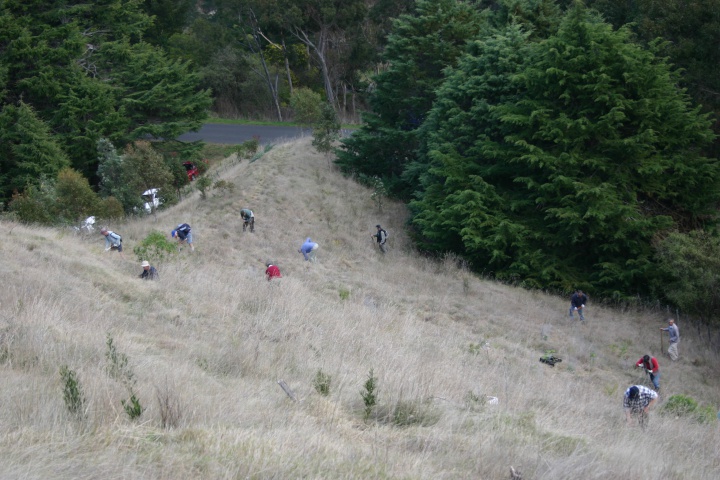Friends fend off Te Mata Park’s weeds
18 July 2019
Media release
Friends fend off Te Mata Park’s weeds
Legendary Te Mata Park is a much-loved feature of the Hawke’s Bay landscape. Gifted to the community in 1927 for the benefit of the public, the park is a culturally significant site and a place where people like to go to enjoy nature, sports and recreation or simply a drive to the summit to take in the sweeping views.

It’s a powerful place. And it is lucky to have a powerful band of volunteers helping to look after it.
For more than 15 years the Friends of Te Mata Park have been meeting up once a month to care for the park, eradicating weeds and planting native trees there.
Their efforts have not gone unnoticed. Friends’ leader and conservation stalwart, Mike Lusk, recently received a civic award from the Hastings District Council for his years of work in the park.
Mike is delighted that the restoration work in the park has been recognized with the award, saying it is the weedbusting work that he is most proud of.
“Weeding could be compared to building something; people don’t notice what they can’t see, like the foundations of a building, but if you don’t get that right the whole process is jeopardized,” he says.
“Weeding is the foundation of all our restoration work in the park. Without it new plants wouldn’t stand a chance.”
A lot of the weedy invaders the Friends have tackled in the park were once garden plants that have ‘jumped the fence’, proving to be formidable, destructive forces when growing where they are not wanted.
Cotoneaster is one of them which, after a tireless campaign, the Friends have as good as eradicated from the park. This has been no small feat. At times the weed has put their agility skills to the test as it was often found growing in difficult sites like cliff faces, requiring the use of ropes to reach the plant safely and treat it.
On occasion, cotoneaster seedlings pop up in the park, but the experienced weedbusters keep an eye out for them and promptly deal to them as soon as they emerge. A good move, as cotoneaster plants mature quickly, produce many seeds and, if left to their own devices, will soon form dense, long-lived stands that can dominate bush areas and crowd out native plants.
Other hardy weeds the Friends have tackled include salvation Jane, a prickly, purply-blue flowering plant that can easily overwhelm open areas, and pink ragwort, which grows readily in dry conditions and spreads easily into the park’s grassy slopes and cliffs.
Further plants on the ‘enemy’ list include Mexican daisy, old man’s beard, wilding pines, spur valerian, and robinia.
Of them all, it is the dainty Mexican daisy that Mike says is particularly tricky to manage. Once a cottage garden favourite, the sale of this plant is now banned as it is a notorious escapee that produces thousands of easily-spread seeds that soon grow to form dense mats, pushing out desired native plants.
The Friends have been able to get rid of Mexican daisy in accessible areas, but it is its ability to grow in the inaccessible cracks and crevices on the park’s limestone cliffs that has so far thwarted their attempts to eliminate it from the park. Growing in these places, it threatens the habitat of some specialised native plants, including a nationally threatened native daphne that doesn’t grow anywhere else in New Zealand in the wild.
If you have the opportunity to visit Te Mata Park, take time to look around and appreciate all things you can (and can’t) see. Notice how the native forest is regenerating and how new plantings are thriving thanks to the absence of habitat-hogging invasive weeds.
New volunteers are always welcome at Te Mata Park. If you are inspired by what the Friends of Te Mata Park have achieved and are interested in helping out with the care of this special place, find out how to get involved at tematapark.co.nz.


 Gordon Campbell: On The Left’s Electability Crisis, And The Abundance Ecotopia
Gordon Campbell: On The Left’s Electability Crisis, And The Abundance Ecotopia NZ Government: Stay Safe On Our Roads This Easter
NZ Government: Stay Safe On Our Roads This Easter YWCA: Global Push Back Against Gender Equality A Growing Crisis In Aotearoa
YWCA: Global Push Back Against Gender Equality A Growing Crisis In Aotearoa Te Pāti Māori: Ngarewa-Packer - Fast-Tracking Seabed Mining Ignores Māori Opposition And Environmental Precedent
Te Pāti Māori: Ngarewa-Packer - Fast-Tracking Seabed Mining Ignores Māori Opposition And Environmental Precedent New Zealand Defence Force: Defence And Customs Strengthen Maritime Security With Uncrewed Surface Vessels
New Zealand Defence Force: Defence And Customs Strengthen Maritime Security With Uncrewed Surface Vessels SPCA: Huge Win With New Dog Tethering Regulations
SPCA: Huge Win With New Dog Tethering Regulations Community Housing Aotearoa: Ngā Wharerau o Aotearoa Says New Partnership Model Helping Ensure Right To A Decent Home Is Realised
Community Housing Aotearoa: Ngā Wharerau o Aotearoa Says New Partnership Model Helping Ensure Right To A Decent Home Is Realised


